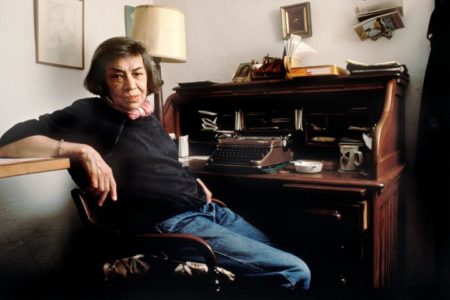Loving Highsmith
Tropic Sprockets by Ian Brockway
[mr_rating_result]Patricia Highsmith was to most, a crime writer known for her book “Strangers on A Train” that Hitchcock made into a film. Highsmith was famous in Europe but less so in the States, until a US version of “The Talented Mr. Ripley” came out directed by Anthony Minghella, starring Matt Damon and Jude Law. The film was glossy, colorful and suspenseful, sparking a new American interest in Highsmith who died of cancer and aplastic anemia in 1995.
 “Loving Highsmith” by Eva Vitija, currently playing at the Tropic, is a breezy overview of her life through the filter of relationships, both romantic and parental.
“Loving Highsmith” by Eva Vitija, currently playing at the Tropic, is a breezy overview of her life through the filter of relationships, both romantic and parental.
Highsmith did not have a loving relationship with her mother. In fact, it was nearly monstrous. Her mother told Highsmith that she drank turpentine in the hopes of having a miscarriage. As horrible as this statement is, Highsmith for the most part, never stopped seeking her mother’s love. She wrote in her journal: I am married to my mother; I’ll never marry another.”
The young Patricia went to New York from Fort Worth, Texas where she was born. She loved the gay clubs, called “Ls.” She loved mingling, tasting conversations and she loved drinking. She was shy, but not overly so.
Highsmith kept a diary without fail, in part to deal with her perpetual nervousness. In writing her journal, she would receive ideas for her novels. She developed a taste for travel.
In New York, she met Marijane Meaker and they fell in love. They moved to Pennsylvania and were happy for two years.
Then Highsmith met a mysterious woman known as “Caroline.” In the film Caroline’s face is distorted, almost like a portrait by Francis Bacon. Highsmith lived for a time in London but the relationship ended.
In the 1980s, the author gets invited on the panel of the Berlin Film Festival. Highsmith meets a striking German woman named Tabea who dresses as a man with a thin dark mustache. It is reported that she has seen and spoken to David Bowie at this time.
In watching the documentary, one feels that her mother blighted if not cursed Highsmith in her pursuit of relationships. There are short interviews of Highsmith’s grandfather’s family, the Coates. They are mystified by the author’s intimate relationships and often giggle, agreeing Highsmith was a cute girl and not feminine. These interviews are interspersed with shots of horses being bound with harsh ropes around the legs and neck as if Highsmith herself was caught in traps throughout her life, be they intimate or parental.
 Interestingly, Highsmith and Tabea were planning a very singular Ripley film, starring Tabea as Tom. By all accounts this would have been quite vivid, as Tom has both male and female traits.
Interestingly, Highsmith and Tabea were planning a very singular Ripley film, starring Tabea as Tom. By all accounts this would have been quite vivid, as Tom has both male and female traits.
According to the documentary, the author asked Tabea to live with her in Montcourt, France. She refused and it broke her heart. Her friend Monique Buffett loved her and Highsmith was able to finish “The Boy Who Followed Ripley.”
The moments featuring Tabea in particular are transfixing as she is frosty and hard to fathom as she boards a bus in pink feathers.
While there are some gaps in the Highsmith narrative as to her mother and lovers, there is enough here to inspire further interest.
Highsmith fled to Switzerland, presumably over taxes, with police raiding her house in France.
Her house in Switzerland is a bunker and there is a wall. She held court with her hermaphrodite snails and her Siamese cats, becoming noticeably and newly bitter and racist—unrecognizable to Marijane Meaker.
Though this documentary is an impressionistic primer, the impressions we do get are vivid: of a young writer chasing a siren at night, both male and female. By day, the author is lost in a daydream of a shadowy man alone on a desolate beach, his face blank with disinterest.
Write Ian at ianfree11@yahoo.com


Ratings & Comments
[mr_rating_form]